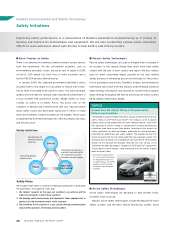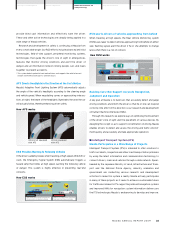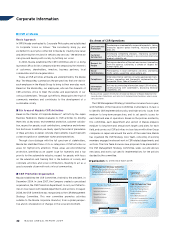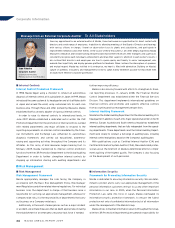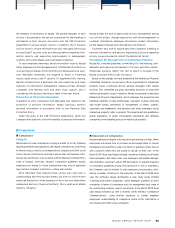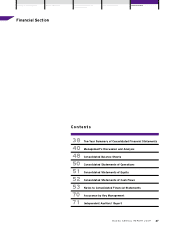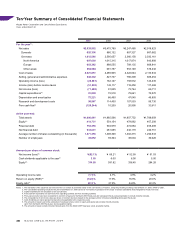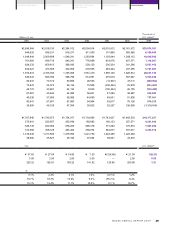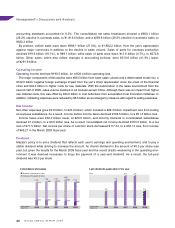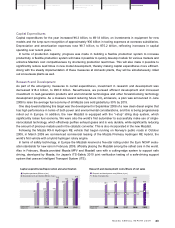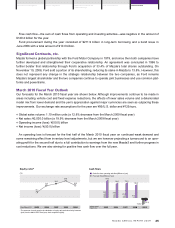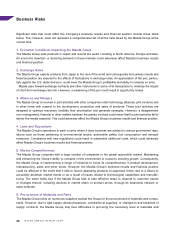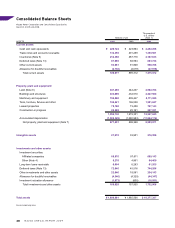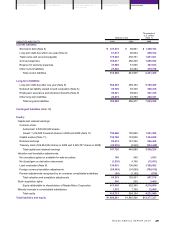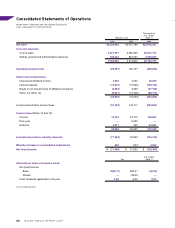Mazda 2009 Annual Report Download - page 42
Download and view the complete annual report
Please find page 42 of the 2009 Mazda annual report below. You can navigate through the pages in the report by either clicking on the pages listed below, or by using the keyword search tool below to find specific information within the annual report.
Management’s Discussion and Analysis
Highlights of the March 2009 Fiscal Year
● Reflecting a global contraction in automobile demand, net sales declined 27.0% to ¥2,535.9 billion; operating
income declined ¥190.5 billion to a ¥28.4 billion operating loss; and net income declined ¥163.3 billion for a
¥71.5 billion net loss.
● Global sales volume was down 7.5%, at 1,261,000 units.
● The dividend was reduced by ¥3, to ¥3 per share.
Overview of the Mazda Group
The consolidated financial statements for the March 2009 fiscal year include the accounts of Mazda Motor
Corporation, 54 consolidated subsidiaries (26 overseas and 28 in Japan) and 14 equity-method affiliates
(5 overseas and 9 in Japan).
Business Conditions
With the global financial crisis that started in the United States having spread to the real economy, both the
domestic economy and overseas economies deteriorated rapidly from the second half of 2008. A global
contraction in automobile demand and a sharply stronger yen during the second half of the fiscal year made the
economic environment surrounding the Mazda Group even more difficult, to a degree not seen in the past.
In addition to wages remaining depressed throughout the March 2009 fiscal year, a major global recession in
the second half of the year, triggered by the U.S. financial crisis, led to major deterioration in consumer sentiment
and corporate earnings, and the size of the domestic automobile industry shrank 12%, to 4.7 million units. Total
demand in the United States contracted 25%, to 11.9 million units, while Europe (including Russia) saw a 12%
decline, to 18.54 million units. The Chinese market, on the other hand, grew 2%, to 9.45 million units.
Consolidated Financial Results
Given this difficult operating environment, Mazda has implemented emergency measures in all areas—
production, sales and development—in response to the economic crisis, while continuing to pursue the mid-term
strategy laid out in the Mazda Advancement Plan. First, production was adjusted to bring inventories to appropriate
levels, all costs including labor and advertising were reviewed, and cost reductions were implemented.
In terms of capital expenditures, priority is being given to targeted investment in forward-looking technology
development programs such as next-generation products and environmental technologies, and less urgent
plans have been postponed. Cost Innovation initiatives are also being accelerated, and we have moved toward
a streamlined and lean management structure.
2,695.6
3,247.5
3,475.8
2,535.9
2,919.8
)'', )''- )''. )''/ )''0
(Billions of yen)
(Years ended
March 31)
E\kjXc\j
82.9
123.4
162.1
28.4
158.5
)'', )''- )''. )''/ )''0
(Years ended
March 31)
(Billions of yen)
Fg\iXk`e^`eZfd\cfjj
40


